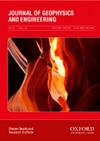High-precision and high-efficiency first-arrival slope tomography via eikonal solvers and the adjoint-state method
IF 1.7
3区 地球科学
Q3 GEOCHEMISTRY & GEOPHYSICS
引用次数: 0
Abstract
First-arrival slope tomography (FAST) introduces first-arrival slopes, corresponding to the horizontal components of the slowness vectors, at the receiver and source positions to supplement first-arrival traveltime for better guiding ray propagation in the media until the best match is achieved with the observed data. FAST can recover the velocity model with higher resolution and precision than first-arrival traveltime tomography (FATT) but is computationally intensive. In this context, we propose a high-precision and high-efficiency approach, referred to as HFAST. HFAST redefines one of the slopes using the reciprocity principle and simultaneously employs the first-arrival traveltime and slopes to ensure high-quality model building. On the other hand, HFAST extracts calculated data and derives the gradient of the misfit function from the solutions of relatively limited forward and inverse problems, resulting in a low computational cost. The cost of HFAST is proportional to the minimum between the receivers and sources, whereas the cost of FAST is scaled to the sum of the receivers and sources. Numerical experiments involving the checkerboard and SEAM II Foothill models demonstrate that HFAST can achieve a higher inversion precision than FATT, especially in the recovery of small-scale anomalies and the presence of velocity reversal. Moreover, HFAST is more computationally efficient than FAST and suitable for managing large data sets. Therefore, HFAST can be regarded as a valuable supplement to current first-arrival-based model building methods and has the potential to be applied in static corrections, prestack depth migration, and waveform inversion in the future.基于正交解算和伴随状态法的高精度高效初到斜坡层析成像
首次到达斜率层析成像(FAST)在接收器和源位置引入与慢度矢量的水平分量相对应的首次到达斜率,以补充首次到达行程时间,从而更好地引导射线在介质中传播,直到与观测数据实现最佳匹配。FAST可以以比首次到达旅行时间断层扫描(FATT)更高的分辨率和精度恢复速度模型,但计算量大。在这种情况下,我们提出了一种高精度和高效的方法,称为HFAST。HFAST使用互易原理重新定义了其中一个斜坡,并同时采用了首次到达行程时间和斜坡,以确保高质量的模型构建。另一方面,HFAST提取计算数据,并从相对有限的正向和反向问题的解中导出失配函数的梯度,从而降低了计算成本。HFAST的成本与接收器和源之间的最小值成比例,而FAST的成本则按比例缩放为接收器和源的总和。涉及棋盘和SEAM II Foothill模型的数值实验表明,HFAST可以实现比FATT更高的反演精度,特别是在小规模异常恢复和速度反转的情况下。此外,HFAST在计算上比FAST更高效,适合管理大型数据集。因此,HFAST可以被视为对当前基于初到的建模方法的一种有价值的补充,并有可能在未来的静态校正、叠前深度偏移和波形反演中应用。
本文章由计算机程序翻译,如有差异,请以英文原文为准。
求助全文
约1分钟内获得全文
求助全文
来源期刊

Journal of Geophysics and Engineering
工程技术-地球化学与地球物理
CiteScore
2.50
自引率
21.40%
发文量
87
审稿时长
4 months
期刊介绍:
Journal of Geophysics and Engineering aims to promote research and developments in geophysics and related areas of engineering. It has a predominantly applied science and engineering focus, but solicits and accepts high-quality contributions in all earth-physics disciplines, including geodynamics, natural and controlled-source seismology, oil, gas and mineral exploration, petrophysics and reservoir geophysics. The journal covers those aspects of engineering that are closely related to geophysics, or on the targets and problems that geophysics addresses. Typically, this is engineering focused on the subsurface, particularly petroleum engineering, rock mechanics, geophysical software engineering, drilling technology, remote sensing, instrumentation and sensor design.
 求助内容:
求助内容: 应助结果提醒方式:
应助结果提醒方式:


